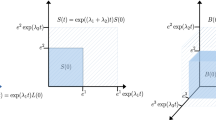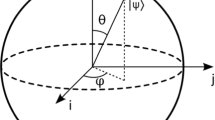Abstract
In this paper, the concepts of con-numbers and con-matrices are proposed by the introduction of conjugate operators into the field of complex numbers, and some properties of these two concepts are derived. In addition, two potential applications of these two concepts are addressed in details. Specifically, a class of quantum systems is expressed in terms of the proposed con-numbers, and the ℝ-linear mapping is represented by con-matrices. These two applications imply the importance of the con-numbers and con-matrices. In addition, some methods are discussed on the construction of the conjugate-operator-induced numbers. Also, some further research directions are provided on these extended numbers and matrices with their applications to systems control.
Similar content being viewed by others
References
Hamilton W R, On quaternions, or on a new system of imaginaries in algebra, Philosophical Magazine and Journal of Science, 1848, 33(219): 58–60.
Abdessameud A and Tayebi A, Attitude synchronization of a group of spacecraft without velocity measurements, IEEE Transactions on Automatic Control, 2009, 54(11): 2642–2648.
Zhu S, Wang D, Shen Q, et al., Satellite attitude stabilization control with actuator faults, Journal of Guidance, Control, and Dynamics, 2017, 40(5): 1300–1309.
Segre C, Le rappresentazioni reali delle forme complesse e gli enti iperalgebrici, Math. Ann., 1892, 40: 413–467.
Luna-Elizarrars M E, Shapiro M, and Balankin A, Fractal-type sets in the four-dimensional space using bicomplex and hyperbolic numbers, Analysis and Mathematical Physics, 2020, 10(1): 13–42.
Yang A T and Freudenstein F, Application of dual-number quaternion algebra to the analysis of spatial mechanisms, Transactions of the ASME, 1964, 31(2): 300–308.
Aydin Y and Kucuk S, Quaternion based inverse kinematics for industrial robot manipulators with Euler wrist, 2006 IEEE International Conference on Mechatronics, Budapest, Hungary, 2006.
Lee U and Mesbahi M, Constrained autonomous precision landing via dual quaternions and model predictive control, Journal of Guidance, Control, and Dynamics, 2017, 40(2): 292–308.
Eirola T, Huhtanen M, and Pfaler J, Solution methods for ℝ-linear problems in ℂn, Helsinki University of Technology Institute of Mathematics Research Reports, 2003, 1–32.
Bachor H A, Ralph T C, and Lucia S, A Guide to Experiments in Quantum Optics, Wiley Online Library, New Jersey, 2004.
Nurdin H I, James M R, and Doherty A C, Network synthesis of linear dynamical quantum stochastic systems, SIAM Journal on Control and Optimization, 2009, 48(4): 2686–2718.
Zhang G and James M R, Direct and indirect couplings in coherent feedback control of linear quantum systems, IEEE Transactions on Automatic Control, 2011, 56(7): 1535–1550.
Zhang G and James M R, On the response of quantum linear systems to single photon input fields, IEEE Transactions on Automatic Control, 2013, 58(5): 1221–1235.
Wu A G, Qian Y Y, and Liu W, Linear quadratic regulation for discrete-time antilinear systems: An anti-Riccati matrix equation approach, Journal of the Franklin Institute, 2016, 353(5): 1041–1060.
Wu A G, Qian Y Y, and Liu W, Stochastic stability for discrete-time antilinear systems with Markovian jumping parameters, IET Control Theory and Applications, 2015, 9(9): 1399–1410.
Wu A G, Qian Y Y, Liu W, et al., State response for continuous-time antilinear systems, IET Control Theory and Applications, 2015, 9(8): 1238–1244.
Catoni F, Catoni V, Boccaletti D, et al., Geometry of Minkowski Space-Time, Springer, New York, 2011.
Acknowledgment
The author is very grateful for Prof. Daizhan Cheng from Academy of Mathematics and Systems Science, Chinese Academy of Sciences to bring the concept of hyperbolic numbers. With such a concept, the paper has been thoroughly revised, and the quality of this paper has been significantly improved. The author also would like to thank Dr. Zhiyuan Dong for providing the example of quantum systems.
Author information
Authors and Affiliations
Corresponding author
Additional information
This work was supported by the National Natural Science Foundation of China for Excellent Young Scholars under Grant No. 61822305, Major Program of National Natural Science Foundation of China under Grant Nos. 61690210 and 61690212, the Fundamental Research Funds for the Central Universities under Grant No. HIT.BRETIV.201907, Shenzhen Municipal Basic Research Project for Discipline Layout with Project No. JCYJ20180507183437860, and Guangdong Natural Science Foundation under Grant Nos. 2020A1515011091 and 2019A1515011576.
This paper was recommended for publication by Editor QI Hongsheng.
Rights and permissions
About this article
Cite this article
Wu, A. On Con-Numbers and Con-Matrices with Applications to Control Systems. J Syst Sci Complex 35, 32–57 (2022). https://doi.org/10.1007/s11424-021-0081-9
Received:
Revised:
Published:
Issue Date:
DOI: https://doi.org/10.1007/s11424-021-0081-9




